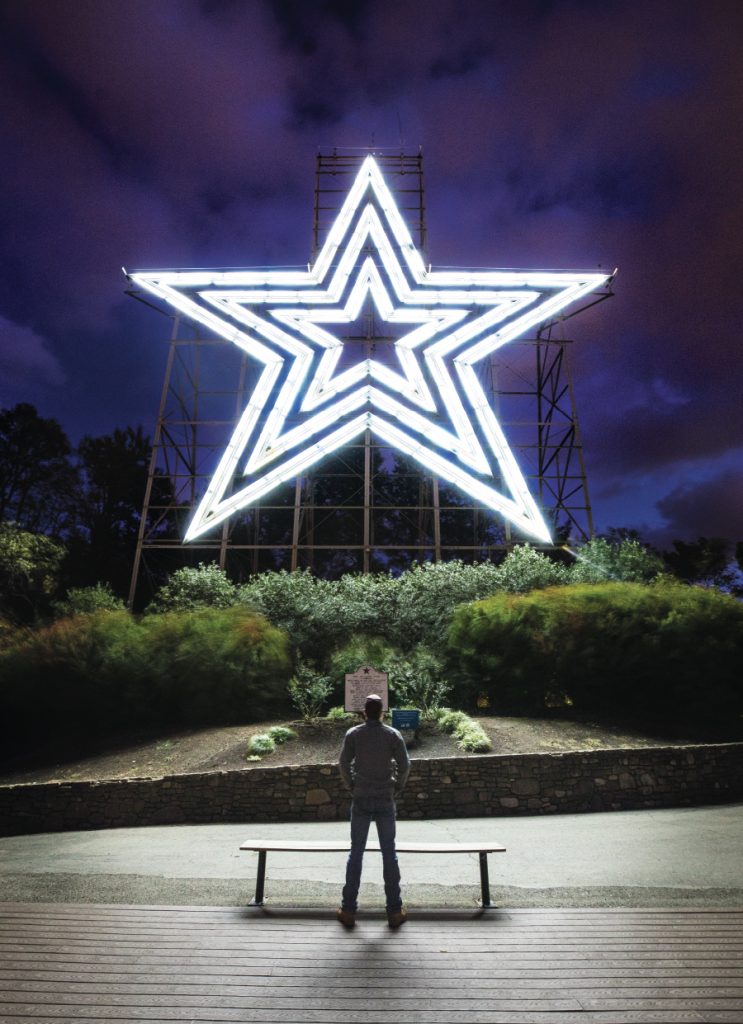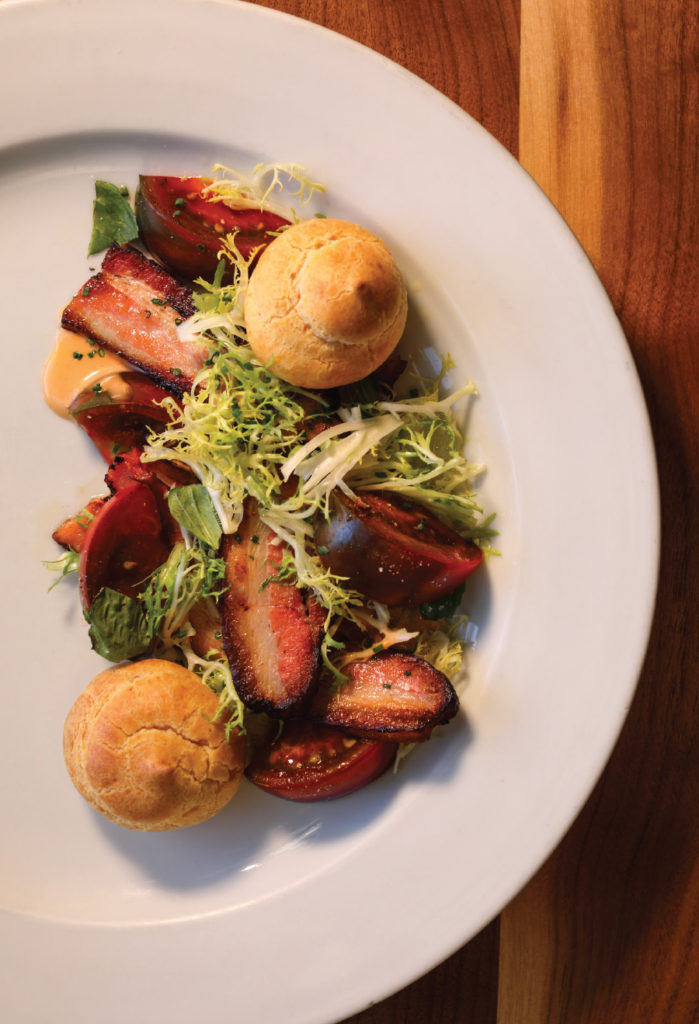Visit Virginia | Roanoke, Star City of the South
Virginia’s largest city west of Richmond has grown into a destination for food, art and the outdoors.

It’s a short trip from downtown to the Roanoke Star, which has lit the landscape since 1949.
The man bellies up to the dimpled counter at Roanoke’s Texas Tavern, under a sign that reads, “We seat 1,000 people, 10 at a time,” and orders his meal in a code familiar to locals. “I’ll take a bowl with,” he says, “and a cheesy western all the way.”
The cook – the handwriting on his paper cap says his name is Donald – silently passes over a Styrofoam bowl of chili topped with chopped onions and a hot dog slathered in chili and cheese. There’s mustard on the counter, but ketchup has to be requested, and even then it’s parsed out grudgingly, in small packets.
The restaurant was founded almost 90 years ago, back when the city was a railway hub with promise. Founder Isaac N. Bullington, an advance man for the Ringling Brothers Circus, chose Roanoke because it was expected to become a big city one day. Instead, the Star City of the South matured into a pleasantly middle-sized town with a bounty of offerings for anyone looking to get away.
The adventurous eater can find everything here, from a greasy burger to gourmet fried Brussels sprouts. Over at Lucky, a friendly upscale restaurant where the chefs and bartenders compete for the most interesting creations, guests can nosh on dishes like the aforementioned sprouts, their umami flavor offset by the bright pop of pickled golden raisins, or they can try the Piedmontese Ribeye with marrow butter and French curry ketchup.

Pastrami-style smoked pork belly with heirloom tomatoes, aoli, and pate a choux pastry from Lucky, an upscale restaurant on Kirk Avenue.
They can enjoy The Hound, an enticing blend of vodka, grapefruit cordial and house-made bitters, served in a glass held upside down to trap the smoke of burning applewood, or opt for something off-menu like The Cube, a glass of Evan Williams small-batch bourbon with a perfect two-inch cube of frozen clove, ginger root and magic spices. As the ice melts, the flavor morphs.
Like this beautiful creation, the city itself is a surprise.
At its core it’s a railroad town, and to get practically anywhere, you cross tracks. Lean over the counter to ask a question at the visitors’ center and your voice reverberates throughout what once was a train-station lobby. Before mechanized amplification, this is where the ticket master stood to announce trains’ comings and goings.
Over at the O. Winston Link Museum, you can find the eponymous photographer’s famous mid-century photos, which captured the demise of the steam rail era – the faces gritty, the eyes earnest.
Down the hill in a 1918 freight station is the Virginia Transportation Museum, which documents the city that was once called Big Lick as it evolved from pony carts to the giant diesel locomotives that have moved local coal for generations.
Nearby is the Center in the Square, home to six museums, including a small city for children, a pinball museum where for one price you can play for hours, and the Mill Mountain Theatre, founded in 1964 and relocated from the mountain in 1983, years after a fire destroyed its original location.
Mill Mountain is also home to the 10,000-pound steel-and-neon Roanoke Star, which shines over the city from the top of Mill Mountain. The Star is as iconic here as the Christ the Redeemer statue in Rio de Janeiro. People flock here for dates and picnics, to propose to their significant others and to pick from the surrounding raspberry bushes. At the star’s base is an overlook with views of the breathtaking Roanoke River valley, home to the trails that earned the Virginia Blue Ridge its designation from the International Mountain Bicycling Association as a Silver-Level Ride Center, one of only 15 in the world and the only one on the East Coast.
Roanoke is also a place of art. A welded-wire man stands high on the balcony of the swooping steel wing of the Taubman Museum of Art, designed by the architect Randall Stout to reflect the region. The 77-foot peak of the glass atrium mimics the Roanoke Star. The rolling hills of the steel roof reflect the Blue Ridge Mountains. Inside are paintings by Norman Rockwell, Susan MacDowell Eakins and Thomas Hart Benton, plus regional artists and rotating shows of international fame.

Cross the tracks to visit the historic Hotel Roanoke, a Tudor Revival structure built with railway money back in 1882. It is now part of the Hilton family of hotels, and it is still the preferred lodging of the well-heeled.
Downtown is home of the City Market, in operation since the 19th century. Surrounding it are shops with Boho-chic clothing, regional art and estate jewelry. Even on a slow day there are eggs and peppers, sausages and hand-thrown pottery. The square is bright with hibiscus and loud with buskers. Restaurants serve Thai and Lebanese, Indian and Italian.
On the corner is Three Notch’d Craft Kitchen and Brewery, one of 15 on Virginia’s Blue Ridge Cheers Trail. Order the BBQ Pork Jar: The bottom layer is creamy mac ‘n cheese, then pulled pork, then fresh slaw, and finally a topping of fried onion straws. Pair it with a cold IPA and enjoy the sight of people strolling through the market.
There is live music in Roanoke almost every night, whether at Big Lick Brewing or at Martin’s Downtown, where they serve up pickle juice-infused vodka shots.
And just outside of town on the Roanoke River is Explore Park, with yurts and tiny-house cabins, primitive camping and river tubing, and a tree-top ropes course of ziplining and tight-rope walking, tunnel clambering and bouncing on a giant branch-high net trampoline full of beach balls. Throw in a couple of kids and you have instant glee.
Roanoke is small enough to get everywhere, yet big enough to disappear. Modern enough for creature comforts, yet rustic enough to sweat it out on a trail. Go for art. Go for the hiking and mountain biking. Go to eat until you’re full as a tick. Just go. And soon.





